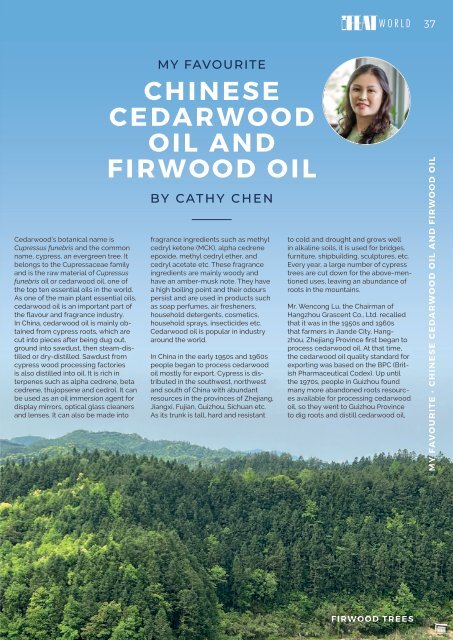IFEATWORLD July 2022
A Members' Newsletter for the International Federation of Essential Oils & Aroma Trades.
A Members' Newsletter for the International Federation of Essential Oils & Aroma Trades.
Create successful ePaper yourself
Turn your PDF publications into a flip-book with our unique Google optimized e-Paper software.
WORLD 37<br />
Cedarwood’s botanical name is<br />
Cupressus funebris and the common<br />
name, cypress, an evergreen tree. It<br />
belongs to the Cupressaceae family<br />
and is the raw material of Cupressus<br />
funebris oil or cedarwood oil, one of<br />
the top ten essential oils in the world.<br />
As one of the main plant essential oils,<br />
cedarwood oil is an important part of<br />
the flavour and fragrance industry.<br />
In China, cedarwood oil is mainly obtained<br />
from cypress roots, which are<br />
cut into pieces after being dug out,<br />
ground into sawdust, then steam-distilled<br />
or dry-distilled. Sawdust from<br />
cypress wood processing factories<br />
is also distilled into oil. It is rich in<br />
terpenes such as alpha cedrene, beta<br />
cedrene, thujopsene and cedrol. It can<br />
be used as an oil immersion agent for<br />
display mirrors, optical glass cleaners<br />
and lenses. It can also be made into<br />
MY FAVOURITE<br />
CHINESE<br />
CEDARWOOD<br />
OIL AND<br />
FIRWOOD OIL<br />
BY CATHY CHEN<br />
fragrance ingredients such as methyl<br />
cedryl ketone (MCK), alpha cedrene<br />
epoxide, methyl cedryl ether, and<br />
cedryl acetate etc. These fragrance<br />
ingredients are mainly woody and<br />
have an amber-musk note. They have<br />
a high boiling point and their odours<br />
persist and are used in products such<br />
as soap perfumes, air fresheners,<br />
household detergents, cosmetics,<br />
household sprays, insecticides etc.<br />
Cedarwood oil is popular in industry<br />
around the world.<br />
In China in the early 1950s and 1960s<br />
people began to process cedarwood<br />
oil mostly for export. Cypress is distributed<br />
in the southwest, northwest<br />
and south of China with abundant<br />
resources in the provinces of Zhejiang,<br />
Jiangxi, Fujian, Guizhou, Sichuan etc.<br />
As its trunk is tall, hard and resistant<br />
to cold and drought and grows well<br />
in alkaline soils, it is used for bridges,<br />
furniture, shipbuilding, sculptures, etc.<br />
Every year, a large number of cypress<br />
trees are cut down for the above-mentioned<br />
uses, leaving an abundance of<br />
roots in the mountains.<br />
Mr. Wencong Lu, the Chairman of<br />
Hangzhou Grascent Co., Ltd. recalled<br />
that it was in the 1950s and 1960s<br />
that farmers in Jiande City, Hangzhou,<br />
Zhejiang Province first began to<br />
process cedarwood oil. At that time,<br />
the cedarwood oil quality standard for<br />
exporting was based on the BPC (British<br />
Pharmaceutical Codex). Up until<br />
the 1970s, people in Guizhou found<br />
many more abandoned roots resources<br />
available for processing cedarwood<br />
oil, so they went to Guizhou Province<br />
to dig roots and distill cedarwood oil,<br />
MY FAVOURITE • CHINESE CEDARWOOD OIL AND FIRWOOD OIL<br />
FIRWOOD TREES

















